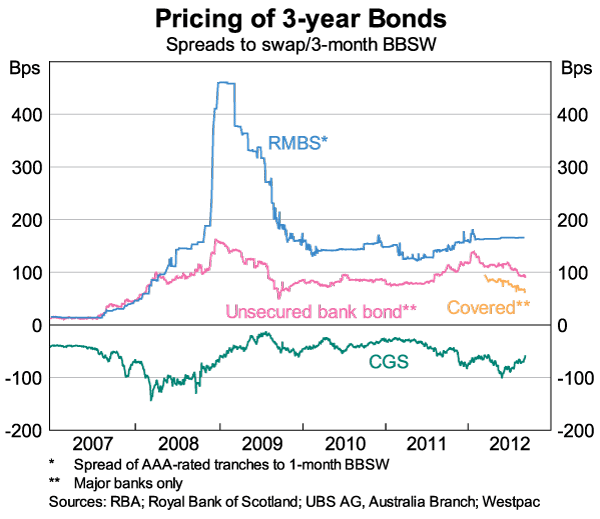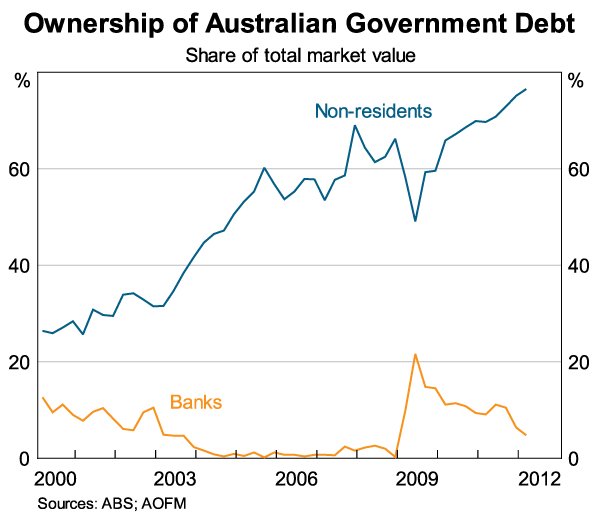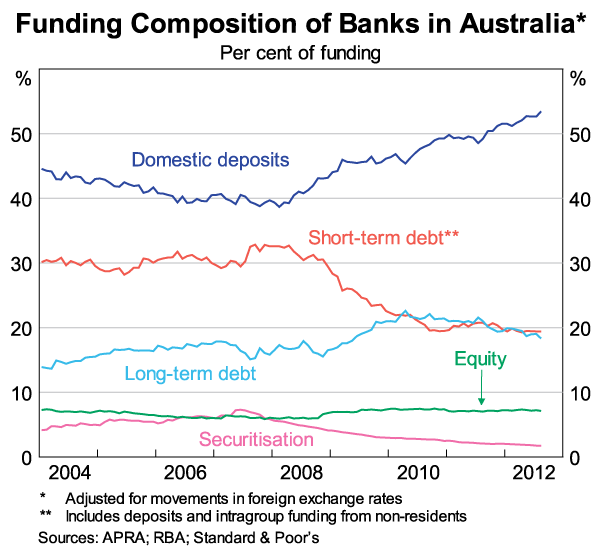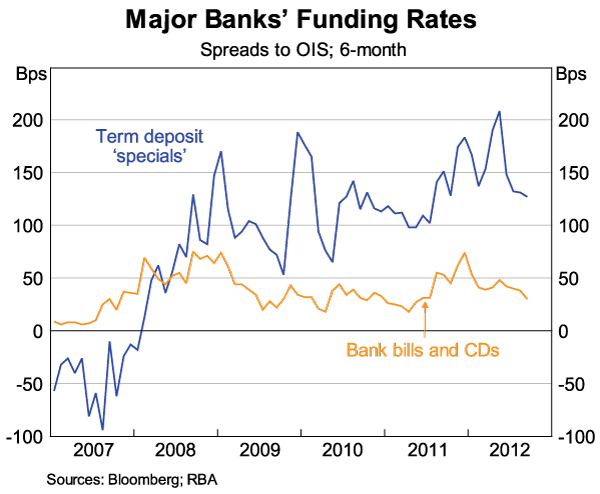Speech Regulatory Reforms and their Implications for Financial Markets, Funding Costs and Monetary Policy
It is a pleasure to speak here today in my home town. Neil Grummitt has spoken about some of the details of the regulatory reform process currently underway in Australia and globally. My aim is to consider some of the broader implications of the reforms.
Before doing so, there is an important point to make. The changes we all see the banking and financial system undergoing are not purely the result of regulatory changes. Rather there are a number of forces all pushing in the same direction. Some of the changes we see are self-imposed, as financial institutions look at the lessons learned over recent years and seek to increase their own resiliency to future developments. Some are being imposed by the market in terms of the availability of both the quantity and price of particular channels of financing. Others reflect pressure from rating agencies.
Currently, all of these forces are generally aligned in changing the structure of the financial system in the same direction, although they may vary in terms of degree. In that sense, the impact of regulation may not be as large as it appears on the surface. Rather regulation is, in many cases, serving to reinforce the other forces at work. But the regulatory changes will be more binding when these other forces are no longer all pushing in the same direction. The experience over many years is that some of these forces are certain to wane when the credit cycle is in full upswing. In the good times, self-discipline can falter under the weight of competitive pressures, as can market discipline. Hopefully in those circumstances, the regulatory framework will continue to impart the necessary restraint.
Today, I'm going to focus on the Basel III reforms. Other reforms, such as those around central clearing and OTC derivatives are also having a significant impact on the way many of you do business, but I will leave them for another time. The Basel III measures will strengthen the requirements for financial institutions' liquidity and capital. It is the impact of some of these reforms on financial markets and on funding costs that I would like to address today.
In thinking about this issue, it is important to remember that the intent of the regulatory reforms is to alter the incentives for financial institutions and thereby bring about changes in behaviour. The prices of various financial products will change from their pre-crisis levels. This is not an ‘unintended consequence’ (a phrase which personally I think is overused) but a desired outcome.
So let me give a quick summary of the Basel liquidity reforms. The 40 or so largest deposit-taking intermediaries in Australia will be required to hold high-quality liquid assets in quantities sufficient to withstand a 30-day period of stress. This liquidity coverage ratio, or LCR, is a much tougher metric than that used in the past, both in terms of the severity and length of the stress period for which sufficient liquid assets need to be available, and in the criteria for what qualifies an asset as liquid.
The test of whether an asset is liquid and of high quality is whether the asset would be able to maintain its value in the private markets during periods of severe stress. The financial crisis revealed that the universe of such assets was a lot smaller than banks (and some of their regulators) had previously assumed. In particular, the liquidity-generating capacity of private sector debt deteriorated significantly during periods of market stress, even where such debt had been highly rated. This was the case for both securitised assets – such as asset-backed commercial paper and residential mortgage-backed securities – as well as unsecured paper. For many of these assets, the only source of liquidity proved to be the central bank. This was true in the Australian market as well as internationally.
In recognition of this, the intent of regulatory reform globally is to require financial institutions to hold more of their liquidity in debt securities issued by sovereigns or other official sector bodies, subject to the requirement that these issuers are themselves highly rated and their securities are liquid. All else equal, this would be expected to widen the spreads between the yields on high-quality sovereign debt and the yields on private debt securities. However, to a large extent, such repricing occurred globally during the financial crisis as the market itself reached the same conclusion as to what constituted a liquid asset. That is, the self-evident lesser liquidity of much private sector debt prompted financial market participants themselves to adjust the liquidity risk premia they required on this debt, quite independently of any direction from regulators.
Within the Australian market, a reassessment of risk and changes in investors' tolerances for assuming such risk have been important in driving the spreads between Commonwealth Government Securities (CGS) and yields on highly rated private debt securities. Since the financial crisis, there has been a considerable widening in these spreads (Graph 1).

It is unlikely that any regulatory initiatives, and certainly not those related to Basel III liquidity requirements, have been behind the strong demand for CGS we have seen in recent years. Indeed, the major source of demand for CGS has come from foreign investors, including central banks, sovereign wealth funds and pension funds attracted by the comparative strength of the Australian economy and the sovereign's credit standing. Non-resident investors now hold more than three-quarters of outstanding CGS. In contrast, the Australian banks own very few CGS (Graph 2).

Within the Australian market, the only assets deemed to meet the Basel standard for liquidity are CGS, semi-government securities, cash and exchange settlement balances at the Reserve Bank. As is well known, under any conceivable scenario, the supply of CGS and semis in Australia will be insufficient for ADIs' liquidity requirements. For this reason, the Reserve Bank has announced it will establish a committed liquidity facility (CLF).[1] On the payment of a 15 basis point fee, ADIs will be able to obtain a commitment from the Reserve Bank to provide liquidity against a broad range of assets under repurchase agreement. Eligible assets will include a range of highly rated private debt securities, including an ADI's self-securitisations. The Bank's commitments to ADIs to provide liquidity against these assets will be recognised by APRA for the purposes of compliance with the Basel III liquidity standards. Central bank committed liquidity facilities will also be used to meet the Basel standards in certain other jurisdictions with insufficient liquid assets.
As I have said before, this arrangement is, to a large extent, the formalisation of the pre-existing liquidity arrangements in Australia and is very much consistent with the principles of central banking described by Bagehot.
The imposition of the fee ensures that the intent of the Basel standard will be met. By charging ADIs for the liquidity insurance the central bank provides, the appropriate incentive is established for ADIs to manage their liquidity risk. At the same time, the design of the CLF will contain the impact of regulatory-induced demand for liquid assets, in an environment where so few outside assets exist.[2]
As noted already, CGS yields have fallen well beyond levels that could have been induced by the liquidity regulations. This is evidenced by the fact that banks own so few of them. For banks, the spreads to interbank rates at which many CGS currently trade implies that settlement balances at the Reserve Bank would be a higher yielding investment and at least as free of risk. Similarly, the large negative spread to swap is confirmatory evidence of the shortage of CGS relative to the strong demand for the asset.[3]
Recent trends within the Kangaroo bond market also illustrate that broader market dynamics have had a greater influence on the relative prices of debt securities than prospective regulatory developments.
When APRA was making its initial assessment of what securities would qualify as liquid assets for the Basel III framework, there was concern expressed in some quarters about the consequences for the Kangaroo market if supranational and foreign agency debt were not considered level 1 assets. Seen from the perspective of today, it is apparent that these concerns were overstated. As AAA rated Kangaroo debt will be eligible for the CLF, it is only the payment of the fee, or liquidity premium, that distinguishes these securities from CGS and semis for regulatory purposes. The subsequent repricing of much Kangaroo debt far exceeds the size of the fee. In many cases, this repricing has rather been due to altered perceptions of their creditworthiness by ratings agencies and market participants.
More generally, great store is often placed in terms of whether an asset is eligible for repo with the central bank or not. Reliance on repo eligibility does not strike me as the cornerstone of a resilient issuance program. But in recent months, we have seen a number of non repo-eligible Kangaroo issues come to market, including from some first-time issuers. This indicates that there are other more important elements that determine investor demand than being considered a level 1 asset or repo eligibility.
In addition to the issue of which securities can be held as liquid assets, the other dimension to liquidity regulation is how many of these assets need to be held. In this regard, the Basel III liquidity framework makes certain assumptions about the likely calls on liquidity that a bank would experience during a 30-day period of stress.
One assumption, based strongly on the experience of the past five years, is that any liquidity commitments ADIs have made to other financial institutions, including structured investment vehicles and conduits, will be called upon in full during the stress scenario. This has significantly lessened the incentives for structures designed to exploit opportunities for regulatory arbitrage, such as the conduits that issued asset-backed commercial paper. Again, though, the decline of many of these structures can hardly be attributed solely to regulatory change. Their viability was undermined when investors and ratings agencies also came to the view that the quality of such instruments was largely tied to the quality of the supporting institution.
This has also seen a decline in the number of mortgage warehouses, as the providers of the warehouses have significantly increased the price to account for the much greater liquidity risk. Most non ADI mortgage providers don't really have a balance sheet to warehouse the mortgages on, so we have seen a marked decline in their number and market share over the past five years.
In terms of the support that an ADI provides to its internal business units, changes to the regulatory framework will alter how ADIs price liquidity and capital usage across the different components of their businesses. By their nature, these internal prices are rarely transparent to outside observers, but the incentives created by such transfer prices can have significant implications for financial markets. This repricing across all product lines is going on currently and still has some way to run. We have already seen its effect on the pricing of undrawn lines of credit, for example, where the increase in the price resulting from their increased liquidity cost has seen a marked reduction in their prevalence.
Another example, observed by the RBA through our market operations, has been the tendency for government bond dealers to fund their positions at rates that exceed the unsecured borrowing rates in the interbank cash market. To the extent that unnecessarily high internal funding rates on these trading desks have fostered such an outcome, the new liquidity regulations may well encourage some revision to these practices.
Calls on a bank's liquidity will also arise when they are unable to roll over or maintain their existing funding. Assumptions regarding the likelihood of this are based on the regulators' views about what forms of funding are more stable than others. Going forward, these ‘run-off’ assumptions should be expected to influence the funding strategies adopted by ADIs.
To give one example: the incentive for ADIs to issue short-term debt to other financial institutions will be considerably reduced under Basel III, as funds borrowed with less than 31 days to maturity would need to be invested entirely in liquid assets. Thus there will be a marked decline in the provision of such debt by banks.
At the same time, the demand for liquid bank debt from other financial institutions, such as insurance companies and pension funds, is increasing, in part as a result of regulatory developments in those sectors.
So there is a decrease in supply and an increase in demand for liquidity. Normally, in economics, such a situation would result in a change in the price (of liquidity in this case) to clear the market. My concern is that it is not clear that the demand and supply curve for liquidity provided by the regulated financial system will intersect at any reasonable price. How this is resolved is not entirely clear. If it were to push the supply of liquidity outside the regulated system, that would not be a good development.
In any case, it is quite probable that new funding instruments will emerge that seek to accommodate the new regulations. In some other jurisdictions, a greater reliance on debt with 31-day notice periods (given the 30-day liquidity stress scenario) has already been observed. Regulators and financial institutions will need to ensure that this does not create a new stress point at 31 days as funding piles up at that maturity.
One product where we are yet to see the effect of the new liquidity regulation on pricing is at-call deposits. Relative to other types of deposits, these products are very expensive from a liquidity point of view, but they still offer interest rates that are a large spread above the cash rate. As banks focus on the liquidity costs of such products, I would expect to see these rates decline relative to those on other types of deposits. Indeed, it would be surprising if the repricing doesn't occur fairly soon given the liquidity regulations take full effect at the beginning of 2015.
However, our liaison with banks suggests that these deposits are particularly sensitive to changes in pricing, so there is a big disadvantage in terms of losing deposits to your competitors if you are the first to reprice for the new regulations. But if an institution has a large reliance on this source of funding, it won't be able to change that reliance overnight on the 31st December 2014. Just like supertankers, funding structures take a long time to change direction, and that change of course needs to be occurring around now.
On the subject of funding, one notable feature of banks' funding over the past three or four years has been the shift away from short-term debt securities toward deposits, in particular, term deposits (Graph 3). This shift has been a deliberate strategy on the part of the banks and has been brought about by significant changes to their pricing structure. The interest rates offered on term deposits to both retail and wholesale customers are now priced well above the rates at which the banks issue equivalent maturity debt securities, such as certificates of deposit (Graph 4).


Given the forthcoming liquidity regulations, a shift toward deposits certainly makes sense. The Basel III framework views deposits as a much more stable source of funding, and has lower run-off assumptions for most types of deposits than it does for wholesale debt securities.
However, as with the relative price of liquid assets, one can't explain all of the movement in deposit pricing in terms of prospective liquidity regulations. The intensity of the competition and the rates paid on some of these deposits far exceed the implied regulatory incentive.
Why, then, are banks willing to pay such high rates for this type of funding? To a large extent, the impetus has come from an internal reassessment of funding resiliency, the rating agencies and the broader market, where a bank's ability to attract deposits has received greater attention since the financial crisis. Quite possibly, some of the focus on deposit-to-loan ratios and similar metrics is misplaced. Regardless, while term deposits appear to be a very expensive source of funding, in the current environment, banks presumably believe the alternatives would be even more expensive for their overall cost of funds.
Nevertheless, the effects of changes in funding composition on the total change in funding costs for ADIs in the past five years has been fairly marginal. The increase in the cost of funding for banks and, ultimately, their customers, has been driven considerably more by a fundamental reassessment within financial markets of the risks associated with credit and liquidity exposures.
The regulatory effort towards promoting more stable sources of debt funding and greater capital buffers for financial institutions is driven by a desire to foster financial system stability. As has been noted before, and as is apparent from the intense competition for deposits, changes in this direction have also been pursued by the banks on their own initiative, presumably in the belief that this will lower their overall cost of funding in the market. To the extent that regulations push ADIs to adopt a funding structure that market discipline would not make them otherwise adopt, the difference is likely to be small and the effect on overall funding costs would be smaller still. Moreover, as both APRA and the Reserve Bank have argued, any costs of this magnitude are well worth paying for a more stable financial system.[4]
As regards the broader macroeconomic impact of the increase in ADIs' funding costs, it is important to remember that in the setting of monetary policy, the Reserve Bank Board is conscious of the various rates at which credit is being priced. Consequently, where there has been an overall rise in the funding cost structure for intermediaries, the Board is able to set its cash rate target to appropriately take into account the effect on lending rates. In the current environment, there has been ample scope to lower the cash rate sufficiently so as to bring these other rates to where they need to be to achieve the desired stance of monetary policy, be they mortgage rates or business lending rates.
In this regard, it is important to stress that the transmission of monetary policy is still very effective in Australia. Not only do lending rates respond to changes in the Board's cash rate target, there is no sense in which the aggregate supply of credit appears to have been constrained by the ongoing changes in ADIs' funding patterns.
Finally, it has been suggested that while the regulations may not have a large impact on the supply of credit in the current environment, banks may have difficulty funding an increased demand for credit. However, I think this concern is misplaced. In an environment where the demand for credit has picked up because the world is a better place, funding conditions for intermediaries are also likely to be much easier. Moreover, from a macro perspective, there is unlikely to be a funding problem for the system as a whole when the world is a happier place, even if an individual institution is not 100 per cent sure where the next funding dollar is coming from.
So, to conclude. There have been a number of significant changes to the structure of financial markets over the past five years, in terms of pricing as well as the composition of funding and lending. Regulatory reforms have certainly played a role in those changes, but one of the main points I hope to leave you with today is that the regulatory reforms have often served to reinforce changes resulting from a self-reassessment or resulting from market pressures. While these forces have all been working in the same direction in the current environment, the regulatory reforms will aim to ensure that these changes to a more stable financial structure endure when the environment is less conducive to self-discipline and as market pressures abate.
Endnotes
Matt Boge provided invaluable help in the preparation of this speech. [*]
See RBA (2011), ‘The RBA Committed Liquidity Facility’, Media Release No 2011-25, 16 November, and Debelle G (2011), ‘The Committed Liquidity Facility’, Speech to the APRA Basel III Implementation Workshop, Sydney, 23 November. [1]
Outside assets are those not issued by the banking system. [2]
Heath A and M Manning (2012), ‘Financial Regulation and Australian Dollar Liquid Assets’, RBA Bulletin, September, pp 43–52. [3]
See, for example, Laker J (2012), ‘Bank Regulation and the Future of Banking’, Remarks to the 41st Australian Conference of Economists, Melbourne, 11 July. [4]
